Related Research Articles

Hadlow is a village in the borough of Tonbridge and Malling in Kent, England. It is situated in the Medway valley, north-east of Tonbridge and south-west of Maidstone.

Leslie Ethelbert George Ames was a wicket-keeper and batsman for the England cricket team and Kent County Cricket Club. In his obituary, Wisden described him as the greatest wicket-keeper-batsman of all time. He is the only wicket-keeper-batsman to score a hundred first-class centuries.

Kent County Cricket Club is one of the eighteen first-class county clubs within the domestic cricket structure of England and Wales. It represents the historic county of Kent. A club representing the county was first founded in 1842 but Kent teams have played top-class cricket since the early 18th century, and the club has always held first-class status. The current Kent County Cricket Club was formed on 6 December 1870 following the merger of two representative teams. Kent have competed in the County Championship since the official start of the competition in 1890 and have played in every top-level domestic cricket competition in England. The club's limited overs team is called the Kent Spitfires after the Supermarine Spitfire.
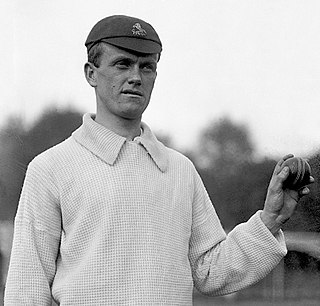
Colin Blythe, also known as Charlie Blythe, was an English professional cricketer who played Test cricket for the England cricket team during the early part of the 20th century. Blythe was a Wisden Cricketer of the Year in 1904 and took more than 2,500 first-class wickets over the course of his career, one of only 13 men to have done so.
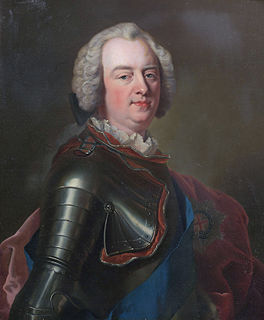
The earliest definite reference to cricket is dated Monday, 17 January 1597. It is a deposition in the records of a legal case at Guildford, Surrey, regarding the use of a parcel of land in about 1550 in which John Derrick, a coroner, testified that he had played cricket on the land when he was a boy. Derrick's testimony makes clear that the sport was being played by the middle of the 16th century, but its true origin is unknown. All that can be said with a fair degree of certainty is that its beginning was earlier than 1550, probably somewhere in south-east England within the counties of Kent, Sussex and Surrey. Unlike other games with batsmen, bowlers and fielders, such as stoolball and rounders, cricket can only be played on relatively short grass, especially as the ball was delivered along the ground until the 1760s. Forest clearings and land where sheep had grazed would have been suitable places to play.
The years from 1726 to 1771 saw cricket establish itself as a leading sport in London and the south-eastern counties of England. In 1726, it was already a thriving sport in the south east and, though limited by the constraints of travel at the time, it was slowly gaining adherents in other parts of England, its growth accelerating with references being found in many counties to 1771. Having been essentially a rural pastime for well over a century, cricket became a focus for wealthy patrons and gamblers whose interests funded its growth throughout the 18th century.
Richard Newland (1713–1778) was an English cricketer in the mid-Georgian period who played for Slindon Cricket Club and Sussex under the patronage of Charles Lennox, 2nd Duke of Richmond. He also represented various All-England teams. Newland made 26 known appearances from 1741 to 1751, including eight in single wicket matches.
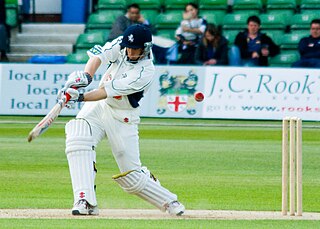
James Cullum Tredwell is an English former international cricketer. A left-handed batsman and a right-arm off break bowler, he played his domestic cricket for Kent County Cricket Club and was appointed as County Captain for the 2013 season. He made his debut for Kent in the 2001 season, nine days before his first appearance for England Under-19s. He often fielded at slip.
Valentine "Val" Romney was an English professional cricketer who played first-class cricket during the 1740s. Considered a specialist batsman, he was mainly associated with Kent sides but also represented All-England. Information about his career is limited by a lack of surviving data, although he is known to have made 11 single wicket and 14 eleven-a-side appearances between 1743 and 1751.
The Napoleonic Wars had deprived cricket of investment and manpower, particularly after 1810 as the conflict in the Peninsular War reached its height and the invasion of France followed. A recovery began in 1815, the year of the Battle of Waterloo, and a more widespread return to normality can be observed from 1816, although it was not until 1825 that inter-county matches resumed when Kent played Sussex.
William Sawyer was an English professional cricketer who played during the 1730s and 1740s. He was mainly associated with Richmond and Surrey. Although information about his career is limited by a lack of surviving data, he is known to have made two single wicket and four other appearances between 1736 and 1747. He spent his whole life in Richmond and was an innkeeper there.
The 1747 English cricket season was the fourth season following the earliest known codification of the Laws of Cricket.
Robert Eures was a noted English cricketer of the mid-18th century. He came from Bexley in Kent and played for Kent county cricket teams as well as for All-England. He is known to have been a good batsman and he was frequently involved in single wicket tournaments which were very popular during his career and attracted high stakes.
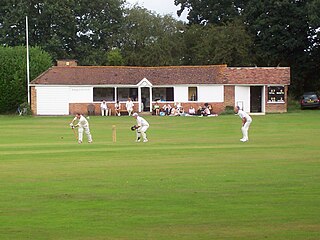
Hadlow Cricket Club was one of the early English cricket clubs, formed in the early to mid eighteenth century. Hadlow is a village in the Medway valley near Tonbridge in Kent.
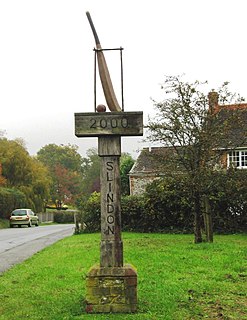
Slindon Cricket Club was famous in the middle part of the 18th century when it claimed to have the best team in England. It was located at Slindon, a village in the Arun district of Sussex.
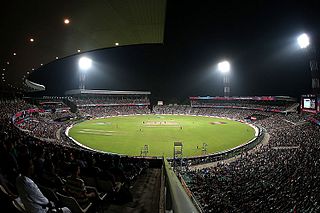
Cricket is a bat-and-ball game played between two teams of eleven players each on a field at the centre of which is a 22-yard (20-metre) pitch with a wicket at each end, each comprising two bails balanced on three stumps. The game proceeds when a player on the fielding team, called the bowler, "bowls" (propels) the ball from one end of the pitch towards the wicket at the other end, with an "over" being completed once they have legally done so six times. The batting side has one player at each end of the pitch, with the player at the opposite end of the pitch from the bowler aiming to strike the ball with a bat. The batting side scores runs either when the ball reaches the boundary of the field, or when the two batters swap ends of the pitch, which results in one run. The fielding side's aim is to prevent run-scoring and dismiss each batter. Means of dismissal include being bowled, when the bowled ball hits the stumps and dislodges the bails, and by the fielding side either catching a hit ball before it touches the ground, or hitting a wicket with the ball before a batter can cross the crease line in front of the wicket to complete a run. When ten batters have been dismissed, the innings ends and the teams swap roles. The game is adjudicated by two umpires, aided by a third umpire and match referee in international matches.
East Kent and West Kent were titles sometimes given to two cricket teams from their respective areas of the English county of Kent which generally played in matches prior to the foundation of the official Kent County Cricket Club in the mid 19th century. West Kent teams have been recorded from 1705 but there is no known record of an East Kent team until 1781. There were seven major matches from 1781 to 1790 in which teams of this type faced each other, although there is doubt about the match titles with sources using different team names.

The earliest definite mention of cricket is dated Monday, 17 January 1597. The reference is in the records of a legal case at Guildford re the use of a parcel of land c.1550 and John Derrick, a coroner, testified that he had at that time played cricket on the land when he was a boy. Cricket may have been a children's game in the 16th century but, about 1610, the earliest known organised match was played and references from that time indicate adult participation. From then to 1725, less than thirty matches are known to have been organised between recognised teams. Similarly, a limited number of players, teams and venues of the period have been recorded.
William Wallace Rodger, known from 1887 William Wallace Rodger-Cunliffe, was an English lawyer, billiards player and first-class cricketer who played for Kent County Cricket Club.
Richard Palmer was an English professional cricketer who played for Kent County Cricket Club between 1873 and 1883.
References
- ↑ Hadlow CC History Archived 14 May 2014 at the Wayback Machine
- ↑ F S Ashley-Cooper, At the Sign of the Wicket: Cricket 1742-1751, Cricket Magazine, 1900
- ↑ G B Buckley, Fresh Light on 18th Century Cricket, Cotterell, 1935